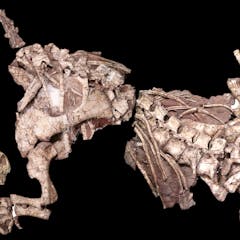
Articles on Human origins
Displaying 1 - 20 of 25 articles

A photo of Lucy’s reconstructed skeleton next to a live four-year-old girl shows how human Lucy was – and how small.

Some time between 1100 and 1700 AD, a Massospondylus bone was discovered and carried to a rock shelter in Lesotho.

New evidence from contested Laos cave site shows humans reached Southeast Asia at least 68,000 years ago.

This was an area in which early anatomically modern humans survived, evolved and thrived, before spreading out of Africa to other continents.

Africa’s large mammal heritage has formed a deep cultural legacy for all of humankind.

Thousands of ancient genomes have been sequenced to date. A Nobel Prize highlights tremendous opportunities for aDNA, as well as challenges related to rapid growth, equity and misinformation.

Shared designs for stone tools across southern Africa show early humans had wide social connections before beginning to migrate to the rest of the world.

The mysterious Denisovans left DNA traces in populations across Southeast Asia and Australasia, but until now no physical signs of their presence outside Eurasia had been found.

Scientists themselves seemed to be unaware that their lack of comment on the absurdity of apartheid was a statement in itself.

A new study doubles the age of ancient DNA in sub-Saharan Africa, revealing how people moved, mingled and had children together over the last 50,000 years.

Stone artifacts and a fossil tooth point to Homo sapiens living at Grotte Mandrin 54,000 years ago, at a time when Neanderthals were still living in Europe.

A new environmental record for a prehistoric site in Kenya helped researchers figure out how external conditions influenced which of our ancient ancestors lived there, with what way of life.

Genetic studies show mingling between populations has been the norm throughout human history.

Mason tirelessly sought to convince officials of the need to recognise and celebrate the African past, and the role that African people played in the making of modern South African society.

New research claiming indigenous Americans traveled to Polynesia is sensational, but the science is flawed and ignores other evidence.

20 years ago, who could predict how much more researchers would know today about the human past – let alone what they could learn from a thimble of dirt, a scrape of dental plaque, or satellites in space.

It’s likely our species doesn’t actually have a single origin.

Geomythology can be a powerful way to inspire more people on the continent to become interested in Africa’s palaeoscience.

No area of archaeology has seen such vibrant change in recent times than how we understand our family tree. Could 2019 be the year we learn more about our mysterious ancestor Homo erectus?

Five major finds this year adds to our understanding of evolution and ancient life history.
